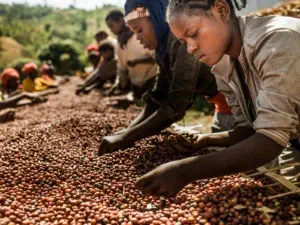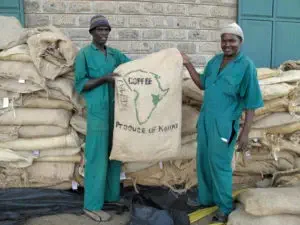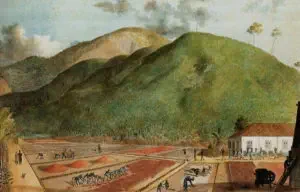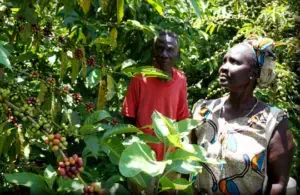Coffee producing countries: Africa

Discover the rich history of coffee in Africa, birthplace of the Robusta and Arabica varieties, which are experiencing growing success in France and England.
In this article, we highlight the challenges and strengths of the main producing countries such as South Africa and Angola, while emphasizing the importance of this crop in the current socio-economic context.
Let yourself be carried away by the diversity of African coffee flavors, a true wealth to explore.
In Africa as elsewhere, when coffee did not grow naturally in the colonies, its cultivation was strongly encouraged. In this way, a very large part of the coffee produced in West Africa (which made up the French empire) is Robusta.
Due to its former conquests, in France we still drink a lot of Robusta coffee, while the British colonies at the end of the 19th century and after World War I were mainly concentrated in an Arabica producing region: East Africa. The coffee primarily consumed in England was then Arabica.
Coffee-producing countries in Africa
Africa is the birthplace of coffee and produces some of the best coffees in the world.
Unfortunately, social, political and economic problems can hinder its development.




South Africa
South Africa has long been a quality Arabica producing country. The coffee plants come from Bourbon and Blue Mountains cuttings, originating from Kenya. The producing region in South Africa is essentially Kwazulu-Natal, which is, along with southern Brazil, one of the only territories that cultivates coffee outside the tropical belts.
The coffee produced in South Africa is still very little exported. One of the main factors is the population: the country is very populous and their harvests are not sufficient, forcing them to import coffee. Another factor is that the constitution of the coffee plants is still fragile.
Angola
The first coffee plants were imported in the 18th century by Portuguese colonists to what is today the People’s Republic of Angola. The country is primarily a producer of Robusta coffee and Arabica. Their harvests are mainly processed using the dry method.
Although Robusta is generally considered to be a coffee of lower quality than others, that from Angola (Ambriz and Amboin) has a much higher quality than the rest. The beans are uniform in size and color. Angolan Robusta is grown on shaded coffee trees in the northern plains, near the Congo delta.
Arabica is harvested on the interior plateau at an altitude of 1800m, benefiting from a much more temperate climate. The Arabica will be mild, relatively neutral. However, since the civil war, production has become rare. Dropping from 3.5 million bags in 1973 to 33,000 in 1994.
Benin
In Benin, Robusta and some Arabusta are cultivated (Coffea ×arabusta is a hybrid coffee plant resulting from the hybridization of robusta coffee (Coffea canephora) and Arabica (Coffea arabica)). However, production is too low to appear in global statistics. Nevertheless, the country continues to export more than it produces (notably through fraudulent activity with neighbors).
Burundi
In this small country, coffee harvesting is the most profitable economic contribution. They export almost all of their production. They cultivate good quality Arabica and a significant quantity of Robusta.
Cameroon
Although one-third of its harvest is Arabica of the Blue Mountains variety, Cameroon is a very large producer of Robusta. Their production is mainly processed using the wet method.
Cape Verde
Colonized by the Portuguese in the 15th century, the first Arabica coffee trees were planted in 1790. Due to severe drought, coffee cultivation was confined to volcanic lands at the highest peaks. The coffee produced, although rare, is mainly exported to Portugal. The inhabitants themselves, being coffee lovers, are obliged to import it, mainly from Angola.
Central African Republic
Former French colony, the Central African Republic continues to export a large part of its production to France followed by Italy. Among the Robusta produced, we can find the ordinary Caephora and the Robusta Nana, a coffee discovered in the wild by shepherds from the Nana River.
Comoros
Located between the coast of Mozambique and the island of Madagascar, four small islands, the Comoros, essentially cultivate Robusta. This coffee is harvested in the shade of banana and coconut trees. The quality of the beans is not bad, they are hand-picked and dry-processed. Production remains very small and is partly consumed by the local population.
Congo
Congo produces Robusta coffee which is classified not according to bean size (as they have uniform sizes), but according to the number of defective beans. The top of the top is the excellent Extra Prima which has none. Overall, it is a medium quality coffee.
Democratic Republic of the Congo
The Democratic Republic of the Congo essentially cultivates Robusta coffee of the Marchand type.
Arabica, which represents about 20% of production, is much more interesting. The coffee trees are grown at high altitudes in the Kivu mountains. Most of the harvested Arabicas have a beautiful bright blue / blue-green color with a homogeneous appearance. The best Arabica coffees from the Kivu mountains are described as fine coffees, perfectly balanced, with body and acidity.
Unfortunately, the production of this Arabica has been in decline for several years. Large plantations are poorly maintained, the best coffees are found in extremely remote regions that face tribal conflicts and tracheomycosis. They must be transported to the eastern border through several countries before they can be exported from the Indian Ocean ports. Kivu Arabica coffees are therefore very rare.
In 2014, the Belgian NGO VECO started a program aimed at reviving the Arabica coffee sector in Congo. This project is sponsored by the International Coffee Organization, and financed by the Common Fund for Commodities, an intergovernmental financial institution established within the framework of the United Nations (source).
Ivory Coast
Much more politically stable and benefiting from monetary and (passive) military assistance from France, Ivory Coast generally ranks second among African coffee producers. In Ivory Coast, a Robusta of average quality is harvested which, due to the consistency and reliability of its agricultural cultivation, makes it attractive to blend manufacturers. It is primarily exported to France and Italy.
A research center in agronomy near Abidjan has developed Arabusta: a very satisfying hybrid coffee.
Ethiopia
All legends and stories about coffee identify Ethiopia as the country of origin of coffee. The coffee processed by villagers still comes from wild coffee trees today. Ethiopia is one of the largest coffee producers in Africa both in quantity and quality, despite extreme poverty and a civil war that ravaged the country several years ago.
It is in Ethiopia that some of the most sought-after coffees in the world are produced. Some coffees produced there are naturally low in caffeine.
The best coffee-producing regions are Simado, Kaffa, Harar and Wollega. Each of these regions produces both natural and washed coffee.
Generally, unwashed coffees are described as having a wild bouquet, which is not necessarily appreciated by everyone, but which can have a captivating aroma. The aesthetics of the coffee beans are uninteresting, even off-putting. Processing carried out without great care is probably the cause.
Among the most renowned coffees, we find Djimmah, Illubador, Lekempti, Harar (long bean or short bean), Limu and Yrgacheffe. It is not recommended to over-roast this coffee due to their unique and delicate aromas. An over-roasted coffee could in this case conceal a lower quality crop.
Gabon
Gabon is a former French colony that mainly produces neutral Robusta. A large part of its harvest is sold to France. It is interesting to note that, as Gabon exports more coffee than it can produce, neighboring countries probably smuggle coffee into Gabon.
Ghana
Ghana is a very important producer of cocoa (economically more attractive than coffee). However, in regions not suited to cocoa cultivation, the government encourages coffee tree cultivation. Ghana harvests ordinary Robusta which is mainly bought by England, Germany and the Netherlands.
Guinea
Tonkin Arabica was introduced in 1895 by the French. However, this country’s climate is not really suited to Arabica cultivation. The country harvests a good “neutral” Robusta in the shade of forests.
Unfortunately, 25 years of authoritarian regime, ethnic rivalries and a global debt do not favor the restoration of a stable market.
Equatorial Guinea
Robusta, Liberica and also some Arabica are grown there. Unfortunately, after the country’s independence in 1968 (after almost 2 centuries of Spanish domination), a dictatorship followed. Today the country is gradually recovering from these dark years and is seeking to restore its cocoa and coffee production.
Kenya
Kenya produces a good quality Arabica coffee. Kenya’s high-altitude washed Arabica even ranks at the top of world Arabicas. The Kenyan industry is subject to strict quality controls by the Kenyan Coffee Board. This board conditions each bag and sometimes blends coffees from different plantations under the “House Blend” label. Bags marked “AA” are of superior quality and highly sought after by enthusiasts.
Kenyan coffee is renowned for its biting, fruity, lemony or citrus taste (due to its high acidity). These are aromas found on the different labels: AA, AB or even the expensive Kenyan peaberries.
Liberia
Despite its mediocre quality, the Robusta produced in Liberia was usable. The United States was its main buyer.
Madagascar
Madagascar is a producer of Robusta (harvested mainly on the slopes of the eastern coast) and Arabica (central plateau). Malagasy coffee is largely exported to France. Overall, the coffee grown in Madagascar is of good quality.
Malawi
Producer of an excellent Arabica, the latter is mainly cultivated in small farms and processed on the highlands. The harvest is still too small for global export, which is unfortunate, as it has a quality close to an average Kenyan coffee.
Mozambique
During the colonial era, Portugal used Mozambique to grow tea (reserving coffee for Angola). Consequently, the Arabica (of the Blue Mountains variety) and the wild Racemosa, which are harvested there, only meet local demand.
Nigeria
The production of Nigerian Robusta is of mediocre quality and irregular. Nevertheless, England remains a buyer.
Uganda
The political stability (since 1986) of this country has contributed to the end of ethnic tensions. This stability has greatly contributed to coffee production, mainly Robusta and an excellent washed Arabica (largely cultivated in the Bugisu region, near Kenya).
Réunion
The era when coffee cultivation was mandatory for every free citizen, when the destruction of a coffee tree was punishable by death and when coffee was the currency of exchange is now over. Bourbon Island (as Réunion Island was called) gave its name to the oldest and best variety of Arabica: Bourbon coffee.
Le Bourbon coffee is a coffee that was believed to be completely extinct. In the 2000s, a few trees were found by enthusiasts and are now being cultivated. They produce the world’s most expensive coffee, a coffee that can exceed €2,000 per kg. For more information on this story, I invite you to consult my following article.
It is from two Réunion coffee trees brought back from Yemen in 1715 that most of the world’s plantations originate.
Rwanda
Coffee is the country’s main source of income. Despite past wars and pests, production is on the rise. The harvested Arabica is generally of good quality, but because of the extremely rich soils, abundant rainfall and sun, Arabica grows rapidly. This gives this coffee a characteristic taste: a grassy flavor, except for premium coffees.
Saint Helena
Annexed by the English East India Company in 1659, coffee production began in 1732. However, cultivation was abandoned. Subsequently and in 1980, an enterprising roaster rehabilitated a small coffee industry. The coffee grown is organic, quality and hand-processed with acidic and well-balanced aromas. Its coffee will probably be recognized in the years to come.
São Tomé and Príncipe
São Tomé and Príncipe produces Arabica grown in rich volcanic soil. The coffee is quality and quite prized. The country is seeking to expand its exports.
Sierra Leone
Until 1985, the country produced a Robusta that was among the best blending coffees in Africa due to its quality and neutrality in the cup. However, subsequently, the country was decimated by coups d’état and war.
Sudan
Sudan has a large number of wild Arabicas that were brought by animals from Ethiopia. Several initiatives have been launched to try to cultivate this excellent Arabica. However, civil war, drought, disease and famine have hindered all of these projects.
Tanzania
Tanzania produces an excellent washed Arabica that recalls Kenyan coffee, even though its acidity is less intense and the general impression is that of a softer and lighter coffee. It is important to note that Tanzanian coffee is not as consistent in quality as Kenyan coffee.
Togo
The country has greatly encouraged Robusta production: an ordinary, consistent, well-graded and neutral Robusta. Despite the size of this country, exports are significant (to France and the Netherlands). The good quality of the road network and the fact that the capital has a port greatly contribute to facilitating its export.
Yemen
The Romans called Yemen “Arabia Felix” and it is this name that later gave its name to Arabica coffee, coffee which was subsequently introduced to the rest of the world. It resembles the coffee of its neighbor, Ethiopian coffee: Moka.
Ethiopian Mokas are generally cheaper, as they are less rare than Yemeni Mokas. However, Yemeni Mokas have wild, gamey, winey, dry and delicate aromas with sometimes notes of chocolate.
Zambia
Zambia produces an Arabica whose taste is close to other East African Arabicas. It particularly recalls Tanzanian coffee.
Zimbabwe
Producer of a good Arabica, it may not be as renowned as that of Kenya, but it shares many of its characteristics. Generally, it is free of aftertaste and has a fruity acidity as well as an honest aroma. Sometimes, it distinguishes itself from Kenyan coffee by its peppery notes.
Other coffee producing countries
To discover coffee producing countries in other continents: Central America and the Caribbean, in South America, in the South Pacific and Southeast Asia, I invite you to click on the corresponding links. Or, return to the general table of contents.
